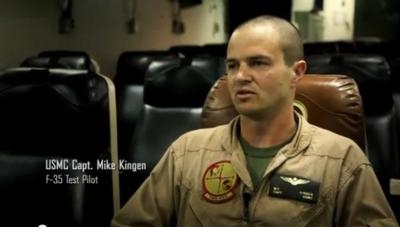Mon, Sep 23, 2013
Marine Corps Test Pilot Praises JSF's Flight Characteristics
Recent ship trials for the Lockheed Martin [LMT] F-35B onboard the USS Wasp [LHD-1] underscored the fifth-generation fighter’s unique capabilities and operational utility according to Marines and sailors alike.

In a video released Thursday, U.S. Navy Capt. Erik Etz stated, “A fifth-generation aircraft, such as the F-35, will open up threat areas where previous legacy fighters that operate off L-class ships weren’t even invited to play. So, an F-35B operating from this type of ship really gives a joint war-fighting commander different options to affect change in the world wherever it is necessary.”
Marine Corps Capt. Mike Kingen (pictured), an F-35 test pilot, added, “Ship-borne capabilities are important for the F-35B because they are important for the Marine Corps. Having F-35B, having a stealth platform that’s organic to that unit will allow us to support the Marines. The F-35 is going to allow future pilots to worry less about stick and rudder skills and more about executing the mission.”
“The fact that the Harrier was not fly by wire at all, there was nothing in between me and the flight controls,” said Marine Corps Maj. Michael Rountree, an F-35 test pilot. “So, I could do things in the Harrier that would very specifically get me killed if I did them incorrectly. Whereas in this airplane there is a level of protection between me and those flight control surfaces. So in a mission – you know up and away from the ship – that’s going to allow me more time to think about the tactical picture, thinking about how I’m going to support the Marines on the ground.”
During the 18-day long ship trials, two F-35Bs conducted a series of tests to determine the aircraft’s suitability for sea-based operations. The aircraft completed 95 vertical landings, 19 of which were conducted at night, and 94 short takeoffs. The ship trials, known as Developmental Test-II, were a key milestone on the Marine Corps’ path to Initial Operating Capability which is scheduled for 2015.
(Image from Navy video)
More News
Aero Linx: Model Aeronautical Association of Australia MAAA clubs are about fun flying, camaraderie and community. For over 75 years, the MAAA has been Australia’s largest fl>[...]
Touchdown Zone Lighting Two rows of transverse light bars located symmetrically about the runway centerline normally at 100 foot intervals. The basic system extends 3,000 feet alon>[...]
“Discovery and innovation are central to our mission at Virgin Galactic. We’re excited to build on our successful record of facilitating scientific experiments in subor>[...]
How To Get A Story On Aero-TV News/Feature Programming How do I submit a story idea or lead to Aero-TV? If you would like to submit a story idea or lead, please contact Jim Campbel>[...]
Student Pilot Reported That During Rotation, “All Of A Sudden The Back Of The Plane Kicked To The Right..." Analysis: The student pilot reported that during rotation, “>[...]
 ANN's Daily Aero-Linx (05.02.24)
ANN's Daily Aero-Linx (05.02.24) ANN's Daily Aero-Term (05.02.24): Touchdown Zone Lighting
ANN's Daily Aero-Term (05.02.24): Touchdown Zone Lighting Aero-News: Quote of the Day (05.02.24)
Aero-News: Quote of the Day (05.02.24) ANN FAQ: Contributing To Aero-TV
ANN FAQ: Contributing To Aero-TV NTSB Final Report: Cirrus Design Corp SR20
NTSB Final Report: Cirrus Design Corp SR20



